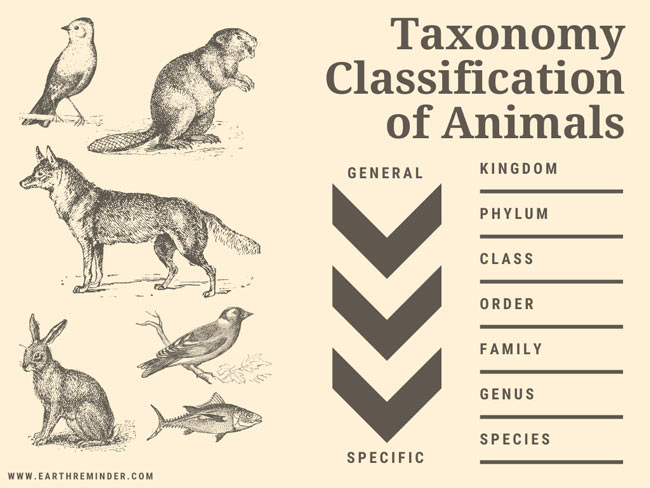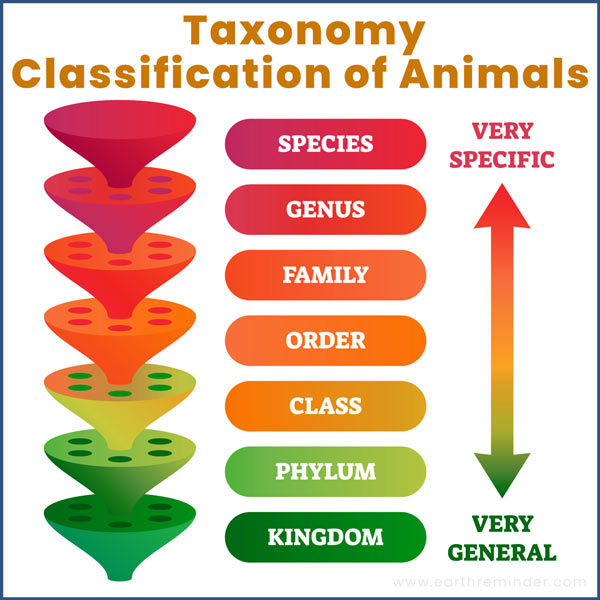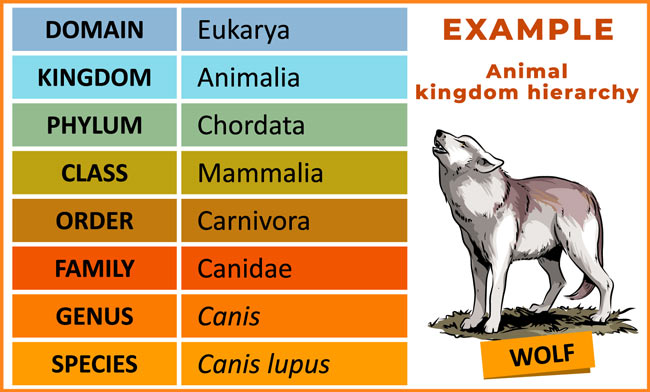Taxonomic Classification of Animals With Examples
Taxonomic Classification of Animals:

Taxonomy is the practice of classifying all living organisms into hierarchical categories. Taxonomy categories are broadly categorized into seven divisions, including kingdom, phylum, class, order, family, genus, and species.
At every step, the organisms are further divided into specific groups. However, the broadest category is the kingdom that comes down to more specific categories, i.e., genus and species.
Table of Contents
Taxonomic Classification of Animals
The biological classification or taxonomy at present is divided into six broad sections, including kingdom Monera, kingdom Protista, kingdom fungi, kingdom Plantae, kingdom Animalia and viruses, viroids, and lichens. Let’s discuss animal kingdom hierarchy.
Kingdom Taxonomic Classification
There are six different classifications of the animal kingdom.
Protista
Protists are unicellular or single-celled and are mainly microscopic. All living organisms are one of the two, prokaryotes or eukaryotes. Archaea and bacteria are examples of prokaryotes. Protists, animals, plants, and fungi are eukaryotes. Eukaryotes are highly organized.
Fungi
Fungi are eukaryotes. Previously, fungi were a part of the kingdom Plantae, but they were separated due to lack of chlorophyll and different physiological and structural features. Fungi have about 144,000 accounted species. Examples of fungi are mushrooms, molds, smuts, yeasts, mildews, and rusts.
Animal
Animals are multi-celled eukaryotes. Animals are diverse; they follow every mode of living present on earth and survive in every habitat. Animals’ strong characteristic is mobility, and they move in pursuit of refuge, food, and mates. Examples of animals are polar bears, crocodiles, blue jay, wasps, eel, whales, and others.
Eubacteria
Eubacteria or true bacteria are single-celled prokaryotes. This is one of the domains known as domain bacteria, while others are domain eukarya and domain archaebacteria. Eubacteria are microscopic and are either gram-positive or gram-negative. Examples of eubacteria are lactobacillus, E. Coli, salmonella, and others.
Plants
Plants are multi-celled eukaryotes. They are essentially known for photosynthetic nutrition, i.e., they produce chemical energy from carbon dioxide, water, and minerals and take help from the sun and pigments. They lack locomotive organs, so their lifespan is stationary. Plants thrive in almost every habitat. Examples of plants are vascular plants, moss, water lily, duckweed, and others.
Archaebacteria
Archaebacteria are single-celled organisms. Archaebacteria can survive in extreme environments including, hot, acidic, and salty surroundings. They are known to survive 190° Fahrenheit (vents of a volcano) and 0.9 pHs acidity. Examples of archaebacteria are euryarchaeota, proteoarchaeota, and others.
Phylum Taxonomic Classification
The next classification in the animal kingdom hierarchy is phylum;
Platyhelminthes
Platyhelminthes are also called flatworms. They generally need one or more hosts for survival. They are parasitic and free-living.
Porifera
Porifera are marine animals called Sponges. Porifera don’t have mouths, and their bodies are full of pores that help them intake water.
Cnidaria
Cnidaria is a diverse animal. The word Cnidaria is originated from a Greek word, cnidos that means stinging nettle. This species is found in every ocean of the world.
Mollusca
Molluscs are diverse marine animals. They have a long fossil record. All mollusks have the same attributes that define their body type.
Annelida
Annelida occurs in terrestrial and aquatic environments. They can regenerate and are generally hermaphrodite, i.e., have both male and female organs.
Chordata
Chordata is a highly evolved animal and is commonly found in every major habitat. They are capable of locomotion. Every vertebrate is considered Chordata.
Arthropoda
Arthropoda is the largest phylum and is terrestrial, parasitic, and aquatic. They breathe through their body as well as gills. They also have sensory organs.
The next classification in the animal kingdom hierarchy is class.

Class Taxonomic Classification
The phylum is further divided into seven animal classes;
Agnatha
Agnatha is a group of jawless fishes such as hagfish and lamprey. Hagfish are cylindrical, scaleless, and soft creatures, while lampreys are eel-shaped, scaleless, and smooth. Both these fishes have burrowing habits due to their elongated bodies.
Osteichthyes
Osteichthyes or bony fish have 29,000 species and are found in marine and freshwater habitats around the world. The main feature of Osteichthyes is that their skeleton is partly made up of true bone. Their size ranges from 12 mm (pygmy goby) to 4.5 meters (swordfish).
Reptilia
Reptilia is evolved from amphibians, and they are the first organisms in the class to adapt to land. Reptiles are cold-blooded terrestrial animals and are mostly found in hot regions around the world. There are three sub-classes of Reptilia, including anapsida (turtles), parapsida (Plesiosaurus), and Diapsida (chameleon).
Chondrichthyes
Chondrichthyes are cartilaginous fish consisting of chimeras, rays, sharks, and skates. Their skeleton is made up of cartilage, and they have a powerful jaw but lack true bone. Whale sharks also come under this category, and they are the second-largest vertebrate.
Amphibia
Amphibians are known to survive both on land and in water. They include toads, frogs, and caecilians. Their skin is glandular, soft, magid, and thin. They have gills (larval stage) as well as lungs (adult stage). They cannot manage their body temperature and prefer to live in temperate, moist climates.
Mammalia
Mammals are warm-blooded vertebrates. They are the most evolved species found in almost every habitat, i.e., deserts, rainforests, polar regions, rivers, and oceans. The fur or hair helps them adapt to every climate and environment. They have an exceptional sense of hearing. Dolphin is also a mammal.
Aves
Aves are warm-blooded and have about 9000 species, and are a flying class of the animal kingdom hierarchy. Their wings help them take flight while their hind legs help them walk, perch, hop, grasp, and swim. They have pneumatic bones and sharp eyesight. They build nests for their young to protect them from predators.
The next classification in the animal kingdom hierarchy is Animal Order.
Order Taxonomic Classification
Each class is divided into six orders:
Artiodactyla
Artiodactyla, or even-toned ungulates, have over 200 species. Artiodactyla are herbivores and omnivores and migrate in search of food and mate. They prefer to live in open habitats but are also found in some aquatic regions. Examples of Artiodactyla are cattle, antelopes, camels, giraffes, deers, and others.
Rodentia
Rodentia or rodents have over 2000 species, almost half of Mammalia’s class. They vary in size ranging from 12 cm (mouse) to 50 cm (marmot). Rodents can be nocturnal as well as diurnal. Some rodents are herbivores, while others are predators. Examples of Rodentia are squirrels, porcupines, chinchillas, beavers, and others.
Primates
Primates have a large body type and have a large brain compared to other terrestrial mammals. The size of primates varies, ranging from 35 grams (Berthe’s mouse lemur) to 180 kg (gorilla). They prefer to live in woodlands, grasslands, and tropical forests. Examples of primates are humans, lemurs, apes, monkeys, and others.
Cetacea
Cetacea includes dolphins, porpoises, and whales. They are carnivores and lack hair or fur. Cetacea is a locomotive and is found in every ocean of the world, from the equator to polar regions. They spend a short time exhaling at the surface of the sea. Examples of Cetacea are blue whales, river dolphins, beaked whales, and others.
Chiroptera
Chiroptera or bats have 925 living species. Bats are divided into two groups, i.e., Microchiroptera and Megachiroptera. Bats are found in tropical and temperate forests, open fields, deserts, and caves. Only bats have true wings. They can live for 30 years or more. Examples of Chiroptera are megabat, natalus, mouse-tailed bats, and others.
Carnivora
Carnivora are generally carnivores, but they have diverse food habits. Carnivora survive in about every habitat in the world, aquatic habitat as well as terrestrial habitat. Carnivora are long-living species (almost a decade) and are both social as well as solitary creatures. Examples of Carnivora are bears, otters, hyenas, raccoons, and others.
The next classification in the animal kingdom hierarchy is family.
Family Taxonomic Classification
The Carnivora further splits into four families:
Felidae
Felidae or cats are found worldwide except for polar ice caps and tundra habitats. Felids are agile hunters and prey on creatures twice their size. Felidae are nocturnal and like to hunt at night. Examples of Felidae are lions, cougar, jaguar, tiger, cheetahs, and others.
Ursidae
Ursidae or bears are large mammals and have 8 species. They occur in every habitat and can vary in size ranging from 65 kg to 800 kg. Bear in captivity can live up to 50 years while in the wild for 25 years. Bears are solitary and are generally nocturnal, although they can hunt during the day as well.
Canidae
Canidae has 34 species. Canidae are more omnivorous than carnivores. They have evolved and are built for endurance rather than speed. They hunt their prey by tackling them to the ground and grabbing their neck. Canidae are found in every content except Antarctica.
Mustelidae
Mustelidae has 56 species. This family constitutes wolverines, fishers, badgers, mink, and others. They prefer to live in tropical, temperate, polar, saltwater as well as freshwater habitats. Their size varies from sea otters (1 m) to least weasel (114 mm) and generally live up to 20 years.
The next classification in the animal kingdom hierarchy is the genus.
Genus Taxonomic Classification
Each animal family is divided into genera. Genus is a rank consisting of species that have common attributes. Genus is a Latin word and means “type,” “sort,” or “origin.”
The genus is the first word (always capitalized) of a scientific name. They are italicized and enclosed in quotes, e.g., Panthera tigris is the binomial name of a tiger where Panthera is the genus name, and Tigris is a specific epithet.
The next classification in the animal kingdom hierarchy is species.
Species Taxonomic Classification
A species of any organism is considered the most basic category in biological classification. They include those organisms that can interbreed, produce fertile offspring, have similar attributes, and share the same DNA.
As Genus name is always the first word and capitalized, while the species name is the second word and is in lower case. For example, the red fox’s biological name is Vulpes vulpes. Vulpes is both genera as well as a species name, but the upper and lower case differentiates them; or another example is a dolphin, its biological name is Delphinus delphis, where Delphinus is the genus name, and Delphis is the species name.
Summary and Conclusion:
Animal kingdom hierarchy was developed in 1700 by Carolus Linnaeus. Taxonomy is broadly categorized into seven groups that classify all living organisms. An example of animal classification of a wolf is: —

Domain—Eukarya
Kingdom—Animalia
Phylum—Chordata
Class—Mammalia
Order—Carnivora
Family—Canidae
Genus—Canis
Species—Canis lupus
If you like this taxonomic classification of animals article, share it with your friends and family members. Feel Free to comment below for any suggestions.